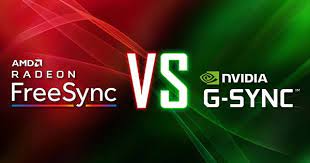Freesync Vs. G-Sync – 2021 Edition
You will almost certainly have seen the terms “G-Sync” and “Freesync” when searching for a new gaming console. Although not all monitors offer this technology, they are usually cheaper than those with it. However, you might be asking yourself, “G-sync/”>Freesync,” which monitor should I choose?
GSync and Freesync (adaptive sync technologies) are developed by Nvidia and AMD, respectively. Adaptive sync adjusts the vertical refresh rate of a monitor to match the frame rate of your graphics cards. Adaptive sync technology is designed to remove screen tears from gaming. This will result in smooth gameplay with no stutters.
This article will explain the differences between sync technologies and help you choose the right one.
What is Adaptive-Sync/ Variable Refresh Rate?
Your GPU sends images very fast to your monitor, and if one of these “frames,” which are shipped outside of your monitor’s refresh rate of 60Hz (refreshes every 1/6th of a second or higher), is delivered, it causes a screen tear.
The “HTMODE_ V-Sync” technology is installed on your graphics card. This technology helps to reduce screen wear by adjusting the frame rate to match the refresh rate of your monitor. However, it can introduce negatives such as input lag.
GSync and Freesync are slightly different. They eliminate input lag by synchronizing the refresh rate of your monitor with the FPS of your graphic card. Your monitor’s refresh rate drops to 45 FPS when your game is 45 FPS. This will result in smooth gaming.
Freesync and G-Sync: What Are the Differences?
Both technologies are used to combat screen tearing in games, but the implementations of each technology are different. The GSync monitors by Nvidia use a proprietary scaler, which is limited to DisplayPort and HDMI inputs. Only DisplayPort supports adaptive sync technology. G-Sync monitors are more expensive than the Freesync options due to the scaler.
Freesync, AMD’s open standard, is free from hardware implementation. This keeps costs low and helps to keep costs down. Freesync monitors provide more connectivity options than older outputs such as DVI, VGA, or HDMI.
G-Sync was initially only compatible with Nvidia graphics cards. However, Nvidia has changed this over the years to allow GSync modules to work with AMD graphics cards. Freesync has initially been compatible only with AMD cards. However, Freesync is now compatible with Nvidia graphics card support.
Our comprehensive guide to G–sync vs. compatible.
G-Sync Or Freesync?
Both are very similar, and Freesync may appeal to you because it is cheaper. Despite this, all compatible monitors have LFC (low framerate compensate) support. LFC will guarantee that the variable refresh rate works even below the adaptive sync rate.
Although this was already mentioned, let’s not forget that a display with an adaptive sync range of 60-120Hz can still experience screen tearing if it drops below 60 or exceeds 120Hz. LFC in Nvidia’s G-Sync prevents screen tearing from occurring and is the main reason why you should pay more for one of these monitors.
AMD recently released Freesync 2 to address this issue. More details will follow.
G-Sync is compatible with GeForce 600 series graphics cards, while Freesync is compatible with Radeon RX 200 Series or newer. You don’t have to worry if your GeForce card is compatible with your Freesync display or vice versa. However, adaptive sync technology will not work unless the model you are using is “compatible.”
Adaptive sync technology mustn’t be required for many gamers to continue playing. If you have AAA titles and use 4K resolutions, this tech may be of limited use. It can be challenging to go back to one of these technologies after you have used it. However, if you have a limited budget, it is worth considering Freesync.
If you are a competitive player, you will want to prioritize specs such as a faster refresh rate over GSync/Freesync.
Freesync 2 Vs. G-Sync Ultimate
Nvidia and AMD have updated their screen-tearing solutions with LFC now available in Freesync2 and HDR support in G-sync final. Freesync 2 is not a replacement for the older tech. However, it has been validated to a higher standard and offers more “premium” features.
HDR monitors are gaining popularity, and AMD’s Freesync2 now supports HDR. We also see the same LFC technology used with the G-Sync module implementations. The technology has been upgraded to meet G-Sync standards by adding low latency and high contrast requirements.
G-Sync Ultimate works in the same way as Freesync 2, but it’s more reliable, more costly, and has dedicated hardware instead of being software-enabled. G-Sync Ultimate features the most recent Nvidia processor. It will provide over 1000-nits brightness along with exceptional contrast and cinematic colors, thereby giving you the best gaming experience.
Freesync Or G-Sync – Which Should You Buy?
G-Sync is the best adaptive sync technology, but the cost of these monitors is so high that you will need to make sure your computer can run these games at its full potential. Freesync is a less expensive alternative that offers excellent gameplay and a fraction of G-Sync costs.
G-sync may be better, but it all comes down to personal needs. Money is not an issue. G-Sync Ultimate monitors will give you smooth 4K gaming like never before. Freesync will be the best option for those with an older system or who have a tight budget but still want to reduce screen tear.
Are you considering a G-Sync monitor or a Freesync one? What was the difference? What is adaptive sync technology best for you? Visit the WPC Community to share your experiences with this growing group of enthusiasts.

















